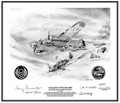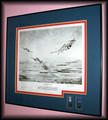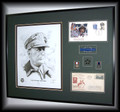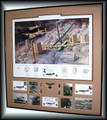 Loading... Please wait...
Loading... Please wait...- Home
- Frmd Collectibles ~ 35% OFF ~ Free Shipping
- Collision Over Büchen (L/E signed by 4 crew members) ~ 35% Off ~ Free Shipping
Product Description
Frame Size: 24" x 27" ~ 425 print Limited Edition autographed by 4 crew members:
Print Number: 140 of 425
Pilot: 1st Lt. Joe Martin, Co-Pilot: Henry Cervantes, Radio Operator Gunner: S/Sgt. Norman Larsen & Tail Gunner: S/Sgt. Paul Gerling
Collision Over Büchen
100th Bomb Group/349th Squadron
“E-Z” GOIN
In one of the last air battles with the Luftwaffe on April 7, 1945 “E-Z” GOIN a B-17G with the “Bloody 100th” Bomb Group had a mid-air collision with an ME-109. The flight crew continued on to bomb the target at Büchen, Germany returned to make a safe landing at their home base in England
September 1944, Berlin, Germany: Ultimate defeat was staring the Nazi’s in the face and Luftwaffe leaders were scrambling for new ideas to turn the tide. Thirty-year old Oberst (Group Captain) Hans-Joachim “Hajo” Hermann said to Reichs-marschall Hermann Goering, “With our new Messerschmitt Me-262 jet fighters coming on-line, the day of the propeller-driven fighter is over. I propose that we gather our Messerschmitt Me 109 fighters and in one massive attack, ram the American bombers in midair. If we crash into them amid-ship, the Me 109’s steel propeller will act as a saw. The sturdy wing with a steel beam running through it will snap the bomber’s fuselage in two, and the long nose will help protect the pilot in order for him to bail out. I believe that the assault will so terrorize the American bomber crews, that they will refuse to fly any more missions. At the very least, it will force them to stop the bombings until more aircraft can be brought over from America to replace their losses. More importantly, the respite will buy us time to improve our fuel supplies and build more Me 262 jet fighters with which to regain air superiority.” He continued, “I estimate that possibly half of our pilots will die in the crashes, but it’s better to lose them in this manner than to have them gradually annihilated with nothing to show for it as is happening today.” Goering favored the idea, but given Adolf Hitler’s dream of world domination, he had reser-vations about requesting the Fuhrer’s approval of a strategy that would clearly acknowledge the desperate nature of their situation. Doubtful that a sufficient number of pilots would volunteer for the Kamikaze-like mission, Hitler sat on it. In the meantime, the American fighters and gunners were downing the less experienced Luftwaffe pilots at an ever-increasing rate. March 8, 1945, Ober-kommando der Luftwaffe: Hitler finally gave the go-ahead, and Goering sent a highly classified message to all fighter and air combat training units. In part, it stated, “I summon you to perform a mission from which your chances of return will be minimal.” With no more than this nebulous disclosure, over 2,000 students and recent graduates of flying schools stepped forward. With that, “Hajo” Hermann formed Rammkommando (Ram Command) Elbe and under great secrecy, the best candidates were interviewed at Stendal, an airfield west of Berlin. The good pilots were ruled out; they were needed alive. Those not deemed brave enough to perform the maneuver were also turned away. A few men backed out; they thought that they were volunteering to attend a training course, not commit suicide. March 20, 1945, Stendal: The selected pilots were wined and dined then fully briefed on the mission. No one had experience ramming aircraft, so most of the instruction the men received was ideological. However, they were extended one option: they could either keep or eject the canopy before the crash, most elected to leave it on for added protection. Meanwhile, at five airfields from where the attacks would be launched, arriving Me 109s and long-nose Focke-Wulf Fw 190s were being stripped of nonessential equipment. On the Me 109s, this included removal of the cannon that fired through the hub of the propeller and one of the two wing-mounted MG131 machine guns. Only sixty rounds were left aboard for the remaining gun. However, because the intent was to shock and dispirit the air crews, the Elbe pilots were ordered to not fire at the bombers and to use the gun only in case of attack by an American fighter. The battle plan called for the stripped-down fighters to climb to altitudes above the normal operating levels of the B-17s and B-24s and heavily armed Mustangs and Thunderbolts. At the same time, the Me 262s would stay low and decoy the American fighters away from the area, thus, freeing the Elbe pilots to dive down into the bombers. During the final stages of preparation, the Germans found that rather than a shortage of volunteers, the overriding problem was a lack of aircraft and fuel. Combat losses together with operational and mechanical problems had whittled down the number of available propeller-driven fighters to no more than 200. Desperately and possibly against their better judgment, they forged ahead anyway.
[as told by Lt. Henry "Hank" Cervantes Co-pilot of B-17G "E-Z" GOIN]
April 6, 1945, Eighth Air Force Headquarters: The next day’s operational plans directed a “maximum effort” against sixteen targets in northern Germany. (The brass called them “ME’s.” Down in the trenches, tongue-in-cheek, we called them “EG’s” for Everybody Goes, including the colonels.) Over 1,300 bombers and 850 fighters were alerted to fly the mission. Of the 40 bomber groups on Bomber Alley, only two would stand-down and of the 14 fighter groups, one would stay home. The Luftwaffe had not seri- ously challenged the bombers since Dresden a month earlier. Therefore, the mission planners had no reason to believe that the Germans would come up in significant numbers on the 7th. Unaware of the Rammkommando Elbe plan, they directed that the bombers fly at exceptionally low altitudes ranging from 15,000 to 22,000 feet. The planners reasoned that this would enable maximum bombing accuracy and spare the crews from the toe-numbing altitudes where they normally flew. This well-meaning blunder effectively increased the separation between the lower-flying bombers and the high-flying Elbe pilots. This would enable them to achieve faster, more lethal speeds before they crashed into the bombers. 0400, April 7, The “Bloody 100th” Bomb Group, Thorpe- Abbots, England: Ceiling zero, visibility zero, standard springtime weather. In the mission briefing room a colonel, pulled back a frayed black curtain to reveal the 100th’s target: Buchen, a small city 50 miles southeast of Hamburg, Germany. Silence was strictly enforced during briefing sessions. Nevertheless, when the crews saw that the string did not extend very far into Germany and that the flight altitude was 15,200 feet, everyone grinned and began mouthing, “milk-run” to each other. After a pause for his audience to savor the moment, the colonel continued, “Upon your arrival back to the local area, expect weather conditions to be heavy cumulus clouds, with bases varying between 200 and 800 feet, and a mile visibility with fog and haze.” The fog delayed the takeoffs until 1030. 1245, Nearing Dummer Lake, Germany: Our crew was aboard B-17G #338514, better known by her name E-Z Goin’, which was emblazoned over a green turtle, blithely toting an ugly black bomb. True to the appellation, she had safely carried us through flak and air battles twenty-four times with little to talk about, and we were inordinately proud of her. As the 100th neared the well-known navigational checkpoint, preceding groups could be heard calling for fighter support. Our pilot, Lieutenant Joe Carl Martin and I looked knowingly at each other and all thoughts of a “milk run” were forgotten. We scrunched our battle helmets down and prepared for battle. On the intercom, Carl called the crew, “Get ready men. Keep your turrets moving. Let them know we’re watching them. Suddenly, tail- gunner Paul Gerling said, “Here comes one from five o’clock high!” I looked to my right just as a diving Me 109 swooshed by so close that we bounced from the shock wave. Inexplicably, the pilot had not fired at us nor was he at his gun-sight aiming at some one below — he was looking at me. We stared at each other for a fleeting moment then he was gone. He crashed into Lieutenant Arthur Calder’s Candy’s Dandy in the squadron below; they exploded and everyone died. Up and down the line, Elbe pilots were crashing into other bombers. 1323, Aboard E-Z Goin: Caarraash! The nose yawed left, we skidded right and the plane waggled like a dog shaking water off itself. Instinctively Carl and I kicked hard right rudder -- both pedals disappeared under the instrument panel then returned to dangle uselessly; the control columns were violently jerking back and forth, the number one engine was streaming white smoke, and all the radios including the intercom were dead. We had no way to ascertain the crew’s con-dition or to get their damage assessments. However, like the stubborn old war-horse unwilling to give up the fight, E-Z Goin’ seemed to still want to fly, so we stabilized the rocking and rolling with the ailerons and hung on. 1328, Over the target: Toggler (bombardier) Ralph Spada released the bombs, and the nose lurched up sharply. Carl rolled the elevator trim wheel forward to add nose-down trim, but the wheel spun ineffectively. Now, we were on a collision course with a B-17 in the squadron above. Quickly, we exerted our combined strength to push the control columns forward. But it was insufficient and at the last possible moment, Carl retarded the throttles. E-Z Goin’ shuddered into a stall and the B-17 slid by close enough for us to see the startled look on the tail-gunner’s face. By trial and error, we found that E-Z Goin’ was most stable at an airspeed of 105-110 miles an hour. This is just above the stall speed at that altitude, but although we could not understand the reason at the time, drag induced by the damaged tail was causing the engines to labor even at that airspeed. As the strung-out remnants of the 100th disappeared into the haze, we wallowed through the sky alone. Now the number one engine oil pressure was dropping rapidly; to prevent a friction-induced fire in the engine, we feathered the propeller and shut it down. This put an additional strain on the three functioning engines. The battle ended, and flight engineer William “Dude” Dudecz toured the ship to assess our condition. He reported back, “Everyone’s OK. Paul (Gerling) says that a Me 109 crashed into us; it just missed hitting him. The left elevator and the top half of the rudder are gone. There’s two big gashes in the fuselage aft of the left gunner’s window and the flight control cables and electric wire bundles are cut there. What’s left of the tail’s flapping up and down so hard that it looks like it might break off. Oh yeah, there’s bullet holes in the left side of the nose. We think a gunner in another B-17 shot out the number one engine and the master radio control box, that’s why the radios are dead.” (The box was in the nose just above navigator Tony Picone’s head). On a B-17, the tips of the horizontal stabilizers are visible from the pilots’ side windows, and I looked back to determine what was causing the control wheels to jerk back and forth so violently. “Carl,” I said, “Dude’s right. The tail’s really bobbing up and down on my side. What’s yours doing? Carl checked his and asked, “Are you sure we’re supposed to be able to see the tail from here?” “Yeah, I’m sure.” “I don’t have one.” Dude tapped me and asked, “Do you want to come back and take a closer look at the damage?” “No Dude”, I replied, “I’m needed here. How’s Paul doing? Is he still in the tail?” “No, I ordered him out of there. He says that when parts from our plane went flying back, they knocked off the left horizontal stabilizer on another B-17 behind us. They’re back there somewhere.”We later learned that the pilot of that aircraft, Captain Joe King was not scheduled to fly that day. However, during the time that we were waiting for the morning fog to lift, he heard that it was to be an easy mission, and pleaded and cajoled until they allowed him to tack-on as tail-end Charlie. Fortunately, he was able to nurse his damaged B-17 to a safe landing. Two P-51s came by. The pilots bracketed us and tried to establish radio contact. However, that was impossible, so they looked us over, shook their heads hard, gave us a “thumbs up,” and headed home. To us, their departure meant that we were no longer vulnerable to enemy attack. Except for emergency equipment, the crew jettisoned everything that was not nailed down. This increased our airspeed by an encouraging blip or two on the dial, and we all breathed a bit easier. An hour later, the coastline came into view and it was decision-time again. Should we try to land on one of the abandoned fighter airstrips below us? If so, we risked committing ourselves to a damaged runway or having the tail break off on touchdown with no medical help available. On the other hand, a decision to continue on to England required that we trust E-Z Goin’ to hold together long enough to cross 150 miles of the frigid North Sea. Further, once there, we would have to let down through the overcast, locate an airfield and land on instruments without radio communications. We de- cided to go on, so I dialed the Thorpe-Abbotts frequency on the Instrument Landing System (ILS). The cockpit display for the ILS instrument consists of two crossed needles. The system uses two fixed radio beams to guide a plane to a landing; one beam provides lateral guidance and the other establishes a glide path to the runway. Stray off course left or right and the error is revealed in the movement of a vertical needle. Stray above or below the glide slope and a hori-zontal needle provides that indication. Visually, the ILS seemed to be operating properly. However, with the radios inoperative, we could not verify what station, if any, the instrument had locked on, so we had to gamble that it would guide us home. We began a long, slow descent into the clouds, and as we neared the ground but still had not broken out, it appeared certain that the morning fog had returned. 1815: We broke out at 700 feet above the ground with a mile visibility and our home runway directly ahead. Waist gunners Norman Larsen and Matthew “Matt” Schipper began firing red flares, and we made a sweeping left turn into a long final approach to the runway. Carl signaled, “Wheels down.” I flipped the landing gear switch, but the motor was dead. Quickly, Dude scurried back to the bomb bay, manually cranked the gear down with the emergency system and the green indicator light came on. We were nearing touchdown when another B-17, also firing red flares, cut in front of us to land. There was no alternative; we had to go around. However, that is impossible with an outboard engine out, the wheels down, and no rudder control. Now Dude laboriously cranked the gear back up and Carl applied power to the three faulty engines. As we staggered over nearby villages at treetop level, I could clearly see traffic coming to a stop and people scrambling off bikes and out of stores to point at us. Given the number of badly damaged B-17s most of them had probably seen, the attention seemed a dubious honor. We returned to the final approach. Carl made a perfect two-point landing, and as everyone held his breath, we gently lowered the tail-wheel to the runway. E-Z Goin’ screeched, grated and groaned in protest (picture a giant beer can being scrunched on the sidewalk), but she held together and a fleet of emergency vehicles trailed us to our hardstand. Five hours had elapsed since the collision, but no one cheered, embraced or shook hands — we were all barely into our twenties, and at that age everyone thinks he is going to live forever. Collectively, the 100th’s gunners claimed eight kills during the battle. I questioned each marksman, but none asked to be credited with shooting-up E-Z Goin’. Twenty-three bombers went down that day. It is known that at least eleven were rammed. Perhaps, due to the bizarre aspects of the battle, exaggerations about our flight persist to this day. One of the more popular tales alleges that, “Because the flight control cables to the tail were severed, the pilots made it back with the help of the crew, who moved to the rear of the plane to raise the nose and to the front to lower it.” When asked to confirm the story, I facetiously reply, “Certainly it’s true. You should have seen me directing traffic when we came in to land then had to go-around.” They forget that the right horizontal stabilizer and elevator were undamaged. When I was in flight school, our Theory of Flight instructor explained the rule in physics that governs why an airplane must have a tail to fly. I didn’t question their wisdom then. But less than a year later, on 7 April 1945, God made an exception to the rule for nine very lucky airmen.














